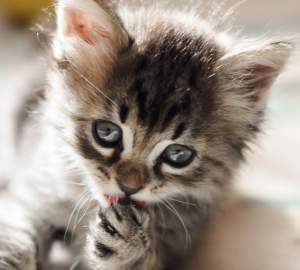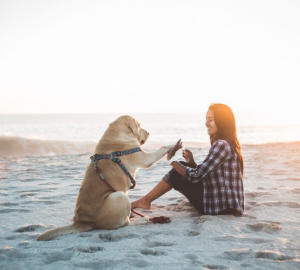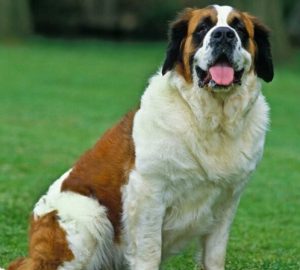Big hearts and fluffy bodies make huskies remarkably appealing dogs. These dogs are graceful and athletic dogs that have high endurance and excitement to work. Siberian Husky dog is a welcoming dog breed that is originated in North-East Asia and is known for its vivacious and mischievous personality.
These dogs are high-energy, intense, affectionate, and gentle when they get the proper care. These dogs have now become popular household pets all around the world, and also in the United States.
If you have enough time to dedicate to your furry friend, then a male or female Siberian husky might be the best dog for you. They can be a wonderful companion when given proper care and attention. Moreover, this dog breed also works well with kids as long as they are properly trained and socialized.
About The Breed
Siberian Husky, a thickly coated dog of medium size and with high strength, was developed with the aim to work in packs and for pulling some loads over massive frozen expanses. These dogs are friendly, fastidious, and dignified.
They have almond-shaped eyes that can be brown or blue and sometimes one of each. They sometimes give mischievous expressions. These dogs are quick and nimble-footed and are well known for their strong and effortless walk.

The weight of Siberian Husky weight is not more than 60 pounds, but these dogs are usually smaller and weigh less than their cousin, named the Alaskan Malamute. These dogs love to be a part of a family and also enjoy the company of other dogs. The inborn feature of Siberian Husky being friendly to others make them indifferent watchdogs.
In addition to these characteristics, they are energetic and can’t resist chasing small animals. It means if you own this dog, you need to have a secure running room for them. Moreover, these dogs are naturally clean, but they also have a little doggy odor.
Siberian Husky History
These dogs are believed to be originated among the Chukchi, one of the tribes of Siberian nomads. If we talk about the history of Siberian Husky, it is relatively unknown, but as per the DNA tests, it is confirmed that they are one of the oldest dog breeds.
Do you know that Chukchi used the dogs as a means of transportation? They treated these dogs as their family dogs. Siberian Husky usually slept with their kids and was served as warm and comfortable beds for them.
Then, in 1908, this dog breed was imported to Alaska, where they were used as sled dogs. Due to their remarkable traits, these dogs were used in All-Alaska Sweepstakes (one kind of dogsled race i.e. 408 miles). Since then, they have been treated as one of the active competitors in the Sweepstakes even today.
It was also reported that the last Siberian Husky was exported in the United States from Siberia in 1930. They were continued to thrive in North America. These dogs still hold several qualities of the Chukchi Sled Dog breed.
In 1930, the Siberian Husky was accepted by the American Kennel Club, and in 1939, this dog breed was recognized by the Canadian Kennel Club.
Siberian Husky Size
The size of an average male Siberian Husky ranges from 21 to 23.5 inches, whereas the female Siberian Husky size ranges from 20 to 22 inches.
The male Siberian Husky weight range between 45 and 60 pounds, while the female Siberian Husky weight range between 35 and 60 pounds.

Siberian Husky Colors
To know about the Siberian Husky coat, these dogs have a dense and double coat that you can see in various different colors. Keep in mind that Siberian Husky colors are not just limited to the combination of some colors, such as black, gray, white, and tan. Most of these dogs have marks on their coat, which include black points, piebald, or pinto.
Siberian Husky Temperament
The temperament of Siberian Husky is described as fun-loving, adventurous, independent, mischievous, ingenious, and stubborn. In addition to these traits, these dogs love to run, and you can see them roaming if they get the chance.
Sometimes, they react extremely forcefully towards other dogs, but if you have other dogs in your home, your husky will be generally good to them. Generally, these dogs are highly social and are known for building lots of human or canine companionship. You can also see them chasing small animals, such as cats or other small pets. Even some of these dogs love to howl, dog, and even chew.
Siberian Husky – Common Health Problems
We can’t ignore the fact that responsible dog breeders ensure to maintain the high breed standards as per the guidelines by the American Kennel Club. Siberian Husky dogs that are bred as per these standards are at low risk of inheriting health conditions. But still, there are chances of dealing with some hereditary health issues i.e., the problems that can occur in this dog breed.
There is some common health condition in Siberian Husky that every dog owner must be aware of. These are:
- Hip Dysplasia
- Hypothyroidism
- Progressive Retinal Atrophy
Other Genetic Predispositions
- Epilepsy
- Laryngeal Paralysis
- High Blood Pressure
- Heart Disease
- Cancer
- Inflammatory Bowel Disease
- Degenerative Myelopathy
- Liver Enzyme
Siberian Husky Living Conditions
When it comes to the living conditions for these dogs, they are not suitable for apartments. They can only live in apartments if they are well-trained and well-exercised. They are also very active indoors and can also work well when left in an open space, like a fenced-in large yard.
Huskies prefer to live in cool climates due to their heavy coats. So, if you are going to place them in the heat, make sure to maintain the temperature by providing your dog an adequate shade and air conditioning. You must also know that this dog breed likes to live in packs.
Siberian Husky Grooming
These dogs are considered a natural breed. Siberian Husky dogs are extremely self-cleaned, and they require just a few baths in 12 months. But, you can groom them anytime if taking your dog to any pet shows or dog events. If you make a habit of brushing your dog every week, it will work great in keeping their coat and skin in good condition.
Though these dogs have a double coat and guard hair, their undercoat is more likely to shed two times in a year. You can also rack out the old coat by using a pin brush, or you can use a metal comb to shed an extra coat.

You should also take care of their nails, so check the length of their nails regularly and make sure to trim them to prevent any kind of foot problems. If your dog is competing in conformation, you need to give extra attention to your dog’s grooming for the best presentation.
Also Read: Stress-Free Tips For Cutting Dog Nails
Siberian Husky Exercise
These dogs are quite active and are also athletic dogs. They need a lot of exercise. When they have to perform any activity, they are the happiest dogs. They require regular exercise for their physical and mental health. Performing activities with their owners help greatly in strengthening their bond between both.
They are bred to run and do not fall behind at every chance they get. Due to this reason, it is important to keep your dog on a leash, in a harness, or in a fenced yard every time. You can find numerous activities that Siberian Huskies love to do. You must know that a busy and active Husky is a happy and healthy dog. If you live in an urban setting, just take your dog for daily walks or dogs’ playgroups, as they will provide great exercise.

Siberian Husky Training
When given early socialization and basic obedience training, all dogs get great benefits in living a happy and healthy life. Siberian Husky dogs are no exception here. If you want your dog to be worked in harness, the training requires a lot of dedication and patience. You can go through books available on training to get started for the appropriate advice, tips, and information.
Make sure to make training sessions a fun experience for you both. Since these dogs are extremely social, they require the company of their humans or other dogs. It is not good to leave your dog at home alone. To avoid running, make sure to keep your dog always on a leash or in a secured fenced-in area.
Siberian Husky Nutrition
For Siberian Husky, it is very important to feed them high-quality food to maintain their healthy skin and coat. It is also required to give them an adequate amount of protein in the food, especially for the working dogs, and also depending on their activity levels.
When there are summers, you can give them lower protein levels, not less than 20%, whereas the dogs that work in harness during winters need at least 32% protein. Make sure to observe each Siberian you have and adjust the amount and type of food accordingly. Make sure not to overfeed your dog and check the weight periodically in order to prevent obesity. The best idea is to check your dog’s nutritional needs with the vet.

Siberian Husky Cost
The price of a Siberian Husky depends on the age, appearance, pedigree, and purpose of getting a dog. The cost of a show-quality purebred Siberian Husky puppy range between $600 and $2,500. If you want to buy a puppy as a house pet, it will be a little cheaper, something from $600 to $1,300.
Siberian Husky puppies that are between the age of 8-12 weeks are the most expensive. The price of these puppies will decrease with age.
If you are looking to purchase a Siberian Husky puppy through a reputable breeder, then it will cost you between $1,000 and $2,500. Also, there is no price difference between female and male Siberian Husky. But, males grow bigger, so you can expect a high monthly expense for food.
However, for a puppy with a higher pedigree and a top breed line, you may have to pay around $2,500 – $5,000.
Types of Siberian Husky
Siberian Husky is the only breed that is recognized by the American Kennel Club. There are several other types of Northern breeds that are also termed as ‘Husky’. Though Siberian Husky is positioned at the 16th most popular dog breed in the US, there are about 30 types of Siberian Husky mixed breeds.
Some of the Siberian Husky mixed breed dogs are:
- Ausky
- Belusky
- Boxsky
- Chusky
- Dusky
- Gerberian Shepsky
- Goberian
- Horgi
- Hug
- Huskimo
- Huskita
- Husky Inu
- Muskiff
- Pitsky
- Siberian Pyrenees
- Pomsky
- Rottsky
- Siberian Boston
- Siberian Retriever
- Siberpoo

Also Read: Golden Retriever Dog Breed
FAQs
Are Siberian Huskies dangerous?
No, Siberian Huskies are not dangerous. These dogs are extremely friendly, which makes them unsuitable for good guard dogs. But, if you have a Siberian Husky puppy and he does not get the amount of exercise and training he needs, you may end up having a puppy that is dangerous to your furniture.
What is the Siberian Husky lifespan?
These dogs live between 12 and 14 years. But, the common cause of death among Siberian Huskies is cancer. Another common health problem seen in these dogs is eye problems. These issues can lessen the quality of life and lifespan.
What is the feeding requirement for Siberian Husky?
The experts recommend feeding around 1.5-2 cups of high-quality dry dog food to your Siberian Husky. This amount needs to be given per day, where you can break it into two even meals. Just like other dogs, the food intake of Siberian Huskies is also different than one another.
Several factors, such as weight, age, exercise, and metabolism, determine the needed amount of food for a balanced diet. Being a dog owner, it’s your responsibility to consider all these factors and control the right amount of food as per the age and weight of your Husky.








